The Bastard Does Not Soar - He Sinks
Tuesday, June 30, 2009
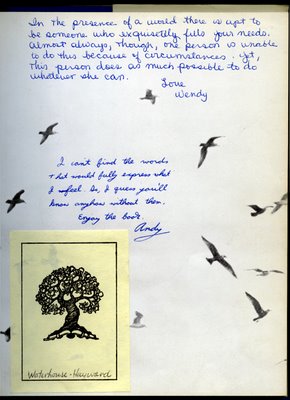
Students are much in my thoughts these days. Schools have changed or at least the ones where I teach have. Gone are the days when you respected a teacher because of age or erudition.
It was sometime around 1972 when I had a pair of students who are possibly the best I ever had. They were both in the 9th grade (let's be Canadian and make that grade 9)in a high school in Mexico City. One was a young girl called Wendy Shanken the other a young man born in Switzerland called Andy Broennimann. Andy came to Vancouver in the late 70s to study at UBC. When he first arrived I told him if he planned to cycle in the winter that he needed to buy chains for his bicycle tires. In his wonderful naïve youth he did go to a bicycle shop to enquire about them! Later on he graduated to a motorcycle and he would take my daughter Ale who was around 10 for thrilling rides up the hill of Springer Avenue in Burnaby where we lived. He left Vancouver and a few years later he sent me a postcard from Cairo. He vanished after that. Wendy showed up in Vancouver perhaps some 10 years ago. She was organizing conferences. She lived with her husband in a small town near Montreal. A couple of years ago she sent me an e-mail and told me how she was traveling for her job all over the world. She named a string of countries in Africa I had never heard of. I became annoyed when she said, “I love to travel and to study different cultures.” It struck me sort of like Barbra Streisand loving people who love people. In another communication from her I decided to reply making believe I was my wife Rosemary. “Rosemary” informed Wendy of the sad occasion of her husband's recent death. It had been sudden. Wendy answered with a poignant letter of condolence and how I had somehow been a part of her life as a teacher. I responded with a statement that my death was a bit premature. Wendy answered, “You bastard.” I have never heard from her again.
Today I reached for my copy of Jonathan Livingston Seagull by Richard Bach. Back in 1972 I had read the story to my 9th graders using a library edition. I had the class mesmerized with the idea that one could will hard enough and be able to soar. When the term ended Andy and Wendy gave me my own copy and reproduced here is their dedication.
It seems now that the last paragraph of the little book might appropriately convey how I feel about students and that perhaps I should give the unruly bunch I face these days more of a chance.
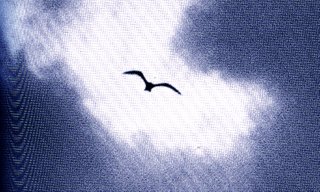
And though he tried to look properly severe for his students, Fletcher Seagull suddenly saw them all as they really were, just for a moment, and he more than liked, he loved what it was he saw. No limits, Jonathan? he thought, and he smiled. His race to learn had begun.
Jonathan Livingston Seagull
Richard Bach
Death For Lunch
Monday, June 29, 2009

Rebecca arrived on Saturday with her new Bikini and told me, “Let’s go swimming today. I want to use my new bathing suit.” I told her that it wasn’t possible as a friend was coming in the afternoon for a chat in the garden and I had already made the commitment. Rebecca insisted, “Can’t you do it just for me?” I explained that my friend was sort of doing me a favour so I could not just think of her.
I decided to tell her some truths.
Rebecca, the man who is coming is Charles Campbell. He used to be an editor at the Georgia Straight and he gave me tons of work when he was there. He left for the Vancouver Sun and started a new Thursday magazine called Queue. With Queue he created a page called Rear Window in which he had me in mind. On that page I would use a picture that I had taken in the past that might have some relevance to the present. I wrote many Rear Windows.
One day Charles came to the house with a special request. He wanted me to take his portrait. He had learned that he had a malignant tumour in his head and that the only way they could reach it was through a dangerous operation involving either accessing it through his palate or through one of his eyes. Not only was his life in danger but should he survive it he would either lose feeling in most of his mouth and or lose one of his eyes. There was finality in the portrait I took of Charles. This one is the only one where he smiled as nicely as he could and somehow even managed to avoid his trademark crooked smile. Jokingly (perhaps to control a fear anybody in his shoes would have had) he told me, “I want you to photograph me so I can remember myself when I was handsome. Who knows what I will look like after the operation."
Rebecca instantly forgot about her swimming and wanted to immediately look at the portraits. “What does he look like now?” She also reminded me that she had met Charles and knew his wife and daughter. I had forgotten that Rebeccca had met the Campbells at a party of a mutual friend of ours.
Charles arrived just in time for a simple lunch of baked beans with melted cheese on top. We had that and my iced tea. At the table Rebecca grilled Charles. At one point Charles mentioned how an aunt of his had had a similar operation and that she had not been as lucky as he had been. She had lost an eye and wore an eye patch. At the dinner table Charles explained with glee a trick his aunt plays on friends. She removes her eye patch and inserts a finger in her mouth and then makes it stick out from her empty eye socket. At that point I think that Charles made a new friend in Rebecca.
Someday I will have to explain to Rebecca that at least half of my extensive files of celebrity portraits is due in part to the golden age of the print media in Vancouver. In that golden age actors, directors, bands and singers from abroad came to Vancouver and granted interviews to promote what they did. Charles and his Georgia Straight would dispatch me to photograph them.
This is not something that I can ever forget nor can I ever thank enough the man who escaped death. I think that my friend John Lekich may have put it best when he may have sweetly told me, “I am sure Charles will make it. After all if he dies, who is going to give us work?”
Rebecca is urging me to photograph Charles again. She wants to make sure I get that indentation near his cheek close to the place where the surgeon peeled Charles’ face back. Luckily as I think back to Saturday’s table conversation I am thankful they were only beans.
A Time Traveler
Sunday, June 28, 2009
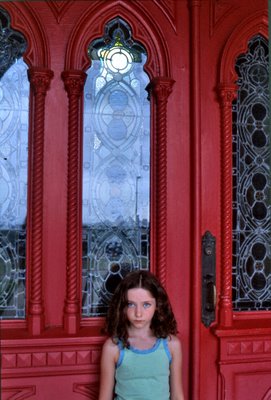
In July 2007 Rebecca Stewart, my granddaughter stood by the big red door of the Gothic revival structure that was the main building of my St. Ed’s High School. A few weeks ago during an electrical storm I moved one of the benches there and placed it right next to where Rebecca had stood. I watched the storm and heard the thunder while gazing north at the Austin skyline, the view that you can see here in back of Rebecca. A lighting bolt hit beyond the soccer field and it sparked down a tree. My company was a little white frog.
As I watched the little frog wait for stray bugs I thought of the complex mechanism of time. I could imagine the taxi that may have brought me from the Greyhound bus station on my return on a Sunday night from my Christmas vacation at home in Nueva Rosita, Coahuila. Even by grade 12 I still missed my home and my mother on that night. The lugubrious and dark Gothic structure had not helped dispell my depression. But the sound of the loud morning bell in the morning; it shook us into instant alertness, never gave me time to think back and my melancholy would fade as we prepared for our breakfast and our first class of the day.

As I rested my head against the big red door I thought of Rebecca and how I had had no inkling of her existence in the future as I had come up the stairs with my suitcase on route to my dorm. Yet I had photographed her by that door 46 years later and I could feel her presence as strongly as I had that taxi. Rosemary had also been with me that July in 2007 and that felt as unlikely. And here I was sitting on the bench leaning my head on the big red door missing them both.

It would seem that time appears to be linear and irreversible when we are young and our future is before us. From my vantage point on that bench with my frog companion, in the time and space of that evening, time was flowing back and forth and perhaps even sideways. I was a time traveler.
Rainbow's End
Saturday, June 27, 2009
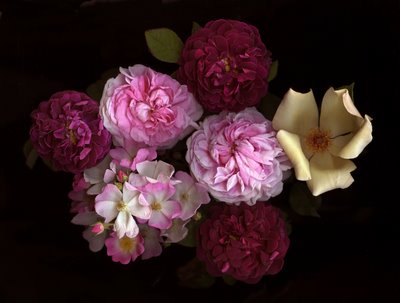
Lauren was 7 today. We had a special dinner with Lauren’s favourite food of thin meat tacos and fresh buttered corn. But dessert was almost a problem. Lauren wanted a white vanilla cake. Her sister Rebecca was the one who baked the cake and she was keen in putting some Bonne Maman raspberry jam to make it pink. There was an altercation involving crying and shouting but in the end Lauren accepted a pink cake. Rosemary had asked Rebecca to bring her digital camera to take pictures of the blowing of the candles. I insisted in using my large camera and light. This went against the grain of Rebecca who wanted the traditional walking into the room with the lit cake while all of us would have been singing happy birthday. My lights and camera make it difficult to be spontaneous. I like to shoot it all planned, posed and calculated. I understand more than ever this conundrum as I and my photographic style fade into obsolescence. We did it both ways and Rebecca got her picture to show her father Bruce who could not be present. He was working. And of course I must wait until Monday noon before I can have my transparency film processed. That is why this blog has no record of the candle blowing.
It was on Friday of last week when Rebecca was still in school that I went to her potted rose garden and cut some of her roses and scanned them. I projected them to Rebecca’s surprise at our joint lecture, A Rose Through a Child’s Eyes, at the World Rose Convention last week. I think that Rebecca’s roses are beautiful. The yellow one on the right is Mrs. Oakley Fisher. The two large pink ones are Rosa 'Königin von Dänemark', the deep red ones are a Gallica Rose, Tuscany Superb and the spray of roses is Ballerina. I do believe she has good taste.
As we left to take them home I noticed the rainbow outside. When we were getting close to their home I said, “It seems that the rainbow is starting at your house.” Rebecca then asked, “Papi, would you like a rose with the colours of the rainbow? I would not like it.” “As a matter of fact,” I answered, “there is a miniature rose called Rainbow’s End which is multi coloured.” Both Rebecca and I concurred that such a rose would never grace our gardens.
Lauren then asked, “Papi is that rainbow far?” “It is very far,” I answered. Lauren then said, “But not as far as Mexico?” Lauren, Rebecca and Rosemary are going to Los Cabos in Baja California in August so Mexico is in Lauren’s mind these days.
The Rose Expert
Friday, June 26, 2009

Last week Rebecca and I spoke in three one-hour sessions (Friday, Saturday and Sunday) at the World Rose Festival that was held at the new Vancouver Convention Centre. Both of us had these tags hanging from our necks that defined us as experts. The theme of the lecture was A rose through a child's eyes. Rebecca exceeded my expectations on how she was going to perform. As a matter of fact I asked her, "Aren't you going to be nervous facing all those people?" She answered something like, "That's not going to happen." On the second day we were preceded by the legendary English rose expert Peter Beales. "Aren't you nervous that we are going to speak after him? " Her reply was a a flat, "No."
We had a trick up our sleeve. We used a basic Power Point program that enabled me to place one, two or more pictures at one time on the screen. Here is an example:
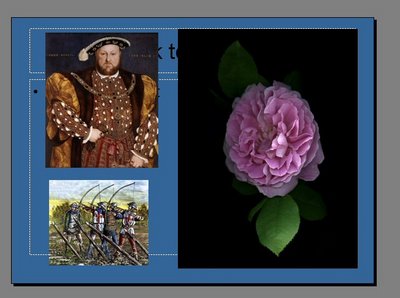
When these images appeared on the screen Rebecca said,"This rose is an English Rose called Mary Rose. Mary Rose was Henry VIII's flagship. She sank on her maiden voyage. Not too long ago they found the wreck. Inside were boxes and boxes of long bows. They put strings on them and they found that one needed a pull of 100 lbs. These English bows defeated the French knights three times during the Hundred Years War. These bows were made of Taxus or English Yew. The plant in the bottom of this picture which is in my grandfather's garden is a taxus."

She, of course, blew them away with erudition! The president of the Toronto Rose Society invited Rebecca to lecture (with an honararium, of course!) if she ever goes to Toronto. And of course, I was most proud. And prouder still when the venerable Peter Beales came up to me and said, "I was impressed by Rebecca."
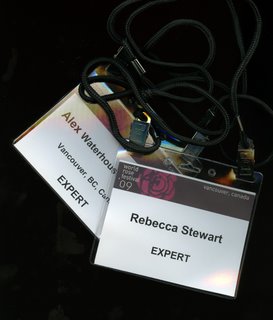
One Brutal & Tragic Sweep Of Death
Thursday, June 25, 2009

I have written about my fascination for Robert E. Lee twice
here and here.
In the Houston airport on my way back from my Austin school reunion I found a book which I had wanted to buy for a long time. It was Michael Shaara’s Pulitzer Prize winning novel (1974) The Killer Angels which is a fictional recreation of the battle of Gettysburg. In one of the blogs I cite above, I wrote of a book written by his son Jeff Shaara years later that featured a young captain in the Mexican American War called Robert E. Lee. It was a passage in Shaara pére’s novel where Lee contemplates death and redemption that brought to mind a singular experience I had with Brother Edwin Reggio CSC at the Assumption Cemetery which is not far from the St. Edward’s University campus. This is the beautiful passage about Lee which occurs late on the night of Thursday, July 2, 1863, the eve of the final stage of the battle of Gettysburg:
…He felt a grave drowsiness. The horse [Traveler] nuzzled his ear; he smiled and rubbed the delicate nostrils. Then he began to drift off. He should go into bed now, but he was not comfortable lying down; he could not breathe. It was better to sit in the night alone with the beautiful horse standing guard above him. It was not so bad to be an old man, drifting. Soon to see the Light. He wondered what it would be like to enter the Presence. They said there would be a fierce blinding light. How could they know, any of them? He wondered: Do you see all the old friends? At what age will they be? Will I see my father?
I had been unaware of this cemetery back in 1961 when I graduated from St. Edward’s High School. It was in that year that all my teachers, Brothers of the Holy Cross, where all alive. They were there at our graduation. I never saw any of them again with the exception of Brother Edwin whom I visited with Rosemary and Rebecca two years ago. I had further found out that all of my teachers with the exception of a very few (Brother Edwin) had all died, some like Brother Francis Barrett at a young age but most of them in their 80s and 90s. I asked Brother Edwin to take me to the cemetery.
The Congregation of Holy Cross has a separate little corner in the Catholic cemetery. There are some nuns and priests but the bulk of the graves are brothers. My beloved Brother Hubert Koeppen has a cross but it said Notre Dame. He is buried in a cemetery that must be adjacent to Notre Dame in Indiana.
I asked Brother Edwin where he was going to be buried. His answer had all to do and depending when he died. It could be in one corner or another. If someone preceded him that corner would be taken. I took his portrait and soon I was overcome by a bitter sweet nostalgia for all the brothers who had made me be the man I am today. I felt myself smiling and I could not figure out why. It has occurred to me in retrospect why I did so. I can answer Robert E. Lee’s question about heaven. His friends will all be there as mine were that morning at the Assumption Cemetery just like I last remembered them (or as Lee would remember them) in 1961. All at their prime.
My classmates tried to find the cemetery later that day but were unable to locate it. They convinced me to accompany them and show them the way. I returned and watched them in silence as they walked from one grave to the next. I had seen the brothers all alive that long ago date in 1961. That memory had been repeated when I had visited the plot with Brother Edwin. For my friends it seemed to be different. It seemed like all of the brothers had all died at the same time in one brutal and tragic sweep of death.
John Arnold - The Spy
Wednesday, June 24, 2009

I have written over three and a half year’s worth of blogs every day. A week ago in Texas my luck run out and I was unable to find a computer in the middle of a large ranch in South Texas. The fact is that the more you write the easier it becomes. Because it is easier it is also more fun.
This one has been fun from the moment I ran into the burly man with the red ball cap and the dark sunglasses at the end of the stairs when I arrived at Austin/Bergstrom Airport on June 10. I went up to the man with the cap expecting to find wires attached to one of his ears (“Could he be an airport security guy?” I thought). I said to him, “You are the man.” His answer was, “Yes.” And that’s when my adventures with John Arnold, the man with the faded semper fidelis tattoo on his left wrist, all began.
In 1960 at St Edward’s High School in Austin, Texas he had been one of three other of my roommates. In picture below, from left to right, that’s John Arnold, Mac Letscher, me and Melvin Medina. John chose to be my protector/bodyguard. I was a nerd but nobody ever bothered me that whole year.

In 1985 I went to Houston and we had a small class reunion, one late evening, poolside, at a Holiday Inn. It was a typically humid and scorching Houston summer. Arnold in a perfectly ironed white button-down white shirt reminded me of Gerald Ford. He didn’t say much.
Since then whenever I have asked any of my former classmates about Arnold the replies are similar, “Wasn’t he a spy?”- “Wasn’t he in the CIA?” or “Wasn’t he in the FBI? Arnold isn’t telling. He will admit that he was an investigating officer of the Securities and Exchange Commission. He will tell you that he sent many people to jail. In fact once when he was accused of taking a bribe he called as witnesses (after convincing the judge) a group he had sent to jail. The former felons testified that Arnold did not even accept free coffees. Or as Arnold put it to me, “They were my friends even though I had put them in jail. Then knew I had no malice and I was doing my job.”
To this day, Arnold’s wife Carolyn and his family will never attempt to wake him up from a deep sleep. Arnold, a US Marine Corps Vietnam veteran from 1965 still has nightmares. He can be a dangerous man not given time to wake up.
To me there are two types of men. There are the ones who have been shot at and perhaps have shot back and killed. Arnold is an example. And then there are those like me who have not experienced that. There is a gulf there that can never be reconciled.
On June 14 Arnold and I climbed into his black Chevrolet F-150 crew cab pickup and began a journey that would help us not only become new friends but discover aspects of ourselves we were ignorant of. It was a journey that would take us 290 miles south via San Marcos, New Braunfels, Buda, San Antonio and a town called Falfurrias to Mike East’s Santa Fe Ranch. Just as soon as we sat in our seats Arnold pointed at the centre console and told me, “Here is where I keep Harley.” He pulled gently and explained, “This is a Kimber, single action, .45 automatic with Crimson Trace laser grips. I have a permit for a concealed weapon and I am allowed to carry her concealed because Texas law stipulates that I can do so when I cross county lines.”
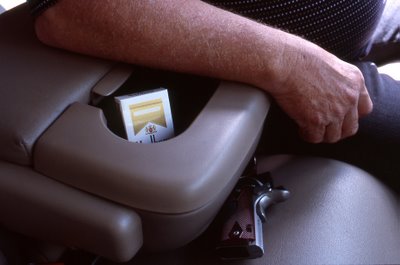
For those like me who might not understand about those Crimson Trace laser grips this is what they are. Without having to bring the gun to one’s eye the gun projects, upon gentle command, a little red laser dot on the target. Arnold explained, “Boy if you see that red dot anywhere near you, you are in trouble. And when you don’t see it you know that you are dead.”
But Arnold is not quick to the draw or quick to point a gun at anybody or anything. “There are four colours that define a situation. A white situation is when you are in the comfort of your home. The moment you leave you are in situation yellow and you have to watch and be careful. You might drive near an accident or a similar such incident. That’s condition red. For condition black you take out your gun and you shoot to kill. If I miss, I shoot again and you are dead.”
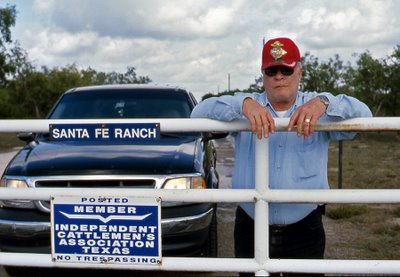
Somewhere past San Antonio Arnold asked, “Are you comfortable with yourself?” I felt vulnerable and nervous about the question so I asked him to explain. In the next few hours we told each other secrets of our innermost soul.
In my previous blog I wrote about Brother Thomas Frey, his smile and his acceptance of his life as it is. This confidence, while not illustrated by frequent smiles I saw in Arnold. Arnold is no saint but he is at peace with his world and the world that surrounds him. I would not suggest that you mess with him but if you learn not to be intimidated by his stern demeanor and observe that he does indeed smile sometimes you might find in him a friend you will take to your grave.

As his buddies at the USMC say, “Semper fidelis.”
The Saint & The Blessed Brother From Montreal
Tuesday, June 23, 2009
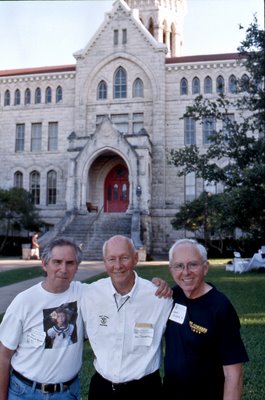
At our all-classes reunion two weeks ago at the former campus of St. Ed’s High School in Austin, Texas and now the campus of St. Edward’s University, I was chatting with my former classmate James Kulleck. He works for NASA in the Mars Rover Program. Even in 1961, when I last saw him, we all called him “The Brain”.
We were having a pleasant exchange of information of our lives when this man, obviously a Brother of Holy Cross, sauntered by us with a smile that was like red to a bull. I could have sworn that such was the grace of his saunter that he may have been levitating. He stopped, introduced himself, “I am Brother Thomas Frey CSC how are you all?” His voice was quiet, melodious and his accent was not Texan. He looked at us straight on with that smile of his and I felt as if he was vacuuming my mind. I felt that no matter what I told him of myself he already knew. We chatted. He told us he had been in California for many years and that he had taught physics. He told us he lived on the other side of the campus at Brother Vincent Pieau Assisted Living Facility. It is where many of the elderly brothers who may be on wheelchairs or be physically impaired in other ways reside at St. Edward’s University. He told us that everybody always noticed his smile but also his receding hairline. He said all this with a soothing voice that made me think the man could have had a soaring career in a midnight FM radio station. He then gave James Kulleck and me little metal medals.
Luckily when I looked at them I knew that they were of Brother Andre CSC who is perhaps, after the founder of the Congregation of the Holy Cross (priests, brothers and nuns), Blessed Father Basil Anthony-Marie Moreau, CSC in Le Mans in 1837, the most famous in CSC history. For me it had a nice connection with my life in Canada. Blessed Brother Andre, (a pre-sainthood in process appellation), in picture below right, was born Alfred Bessette in a town near Montreal in 1845. By the time he died in 1937 he was revered in French Canada and credited with thousands of miraculous healings.
That very day when having lunch at St Joseph’s Hall with my former religion teacher and saxophone instructor, Brother Edwin Reggio, CSC I had picked up a little brochure on Brother Andre. I decided to see if Brother Thomas Frey could be challenged and lose his cool so I began, “Ah, yes! Brother Andre who was considered a quack by many.” Brother Thomas kept his smile as I told the story.
At one time a woman in Montreal was dying of a blood hemorrhage and her husband was desperate. She instructed him to fetch Brother Andre. Her husband insisted that he would then be the laughingstock of the city when people found out he had summoned the man of the healing powers. When the woman got worse the man relented and went to Brother Andre’s residence and begged the man to accompany him back. Brother Andre calmly told the distraught man, “Go back to your wife. She is well now.” And so she was.
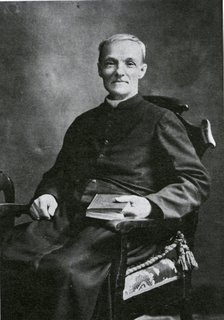
Brother Thomas lingered for a while and then he walked off in the direction of Brother Vincent's. Could it have been the late afternoon sun which as a backlight gave the man a halo? I watched him until he disappeared.
Brother Thomas (78) remained in my mind for the rest of the day. I had been impressed by his calm peace with himself and the world. Later that evening when I ran into Brother Edwin I asked him why it was that the healthy looking Brother Thomas lived at Brother Vincent's. Brother Edwin answered, “He administers to the brothers in his care.”
It would seem that both brothers are blessed but only one was blessed with more hair.
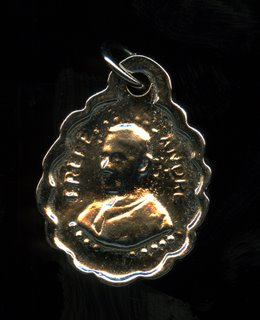
Gerry Gilbert - The Laughing Poet
Monday, June 22, 2009
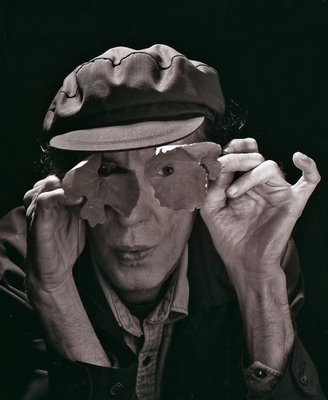
Hello Alex
Because you always spoke of your high regard for Gerry Gilbert and his work, I thought you might like to know, if you hadn't heard already, that Gerry died in St. Paul's Hospital last Friday at 6PM. Both his children Tamsin and Jeremy had paid recent visits, and Marlene Swidzinkski, a dear old friend was with him in his final hours.
There's a short notice on our Schroedinger's Cat blog, plus photos.
Schroedinger's Cat
We will probably organize a memorial reading later in August.
I'll keep you posted.
Best regards
Jamie Reid
Fork
stick around
or
the poem may never end
Gerry Gilbert
Azure Blues, Talonbooks 1991
Gerry Gilbert was my favourite Canadian poet. He helped me access poetry like no other poet has. I loved Gilbert because he always lived in poverty or close to poverty. He had his damned principles of which he never relaxed or let go.
Music Lessoning
they played some liszt on the radio today
it wasn’t listening
they played some satie on the radio today
it wasn’t satisfying
they played some apollinaire on the radio today
it wasn’t appalling
they played some rock on the radio today
it wasn’t stoned
they played some jazz on the radio today
it wasn’t the actual sound the musicians had ground,
which is full of pits & indeterminacies
they played some pussycat on the radio today
it wasn’t noticed by the cat of our house
Gerry Gilbert
sex + the single mushroom
grOnk inadmissible series 5
1995
Gerry Gilbert taught me to laugh in tough times.
Gerry Gilbert's bicycle
Mike East - Pater Familias
Sunday, June 21, 2009

When I first met Mike East back in 1959 at St. Ed’s High School, a Catholic boarding school in Austin, he was wearing a cowboy shirt, faded jeans, boots with spurs and a cowboy hat. Mike had blue eyes and one of them was slightly off so it was almost uncomfortable to look at him. He was very quiet and shy. When he spoke, his Spanish was far better than his English.
When I met him again at his South East Texas Santa Fe Ranch last week, Mike was still soft-spoken and shy. He was wearing beautiful spurs that had a comforting quiet jingle when he walked. Mike denied that he had been wearing spurs that first time around.

Watching the Patrón run his ranch was eye-opening for me and much more so in that we (my companion John Arnold and I were one year ahead of Mike) had the unusual invitation to visit and spend time with a most private man. We met his family, including his lovely companion Leticia who seemed to gently be the real behind-the-scenes patrón.
Watching Mike lose his quiet cool (he baby-talked in Spanish) with his 15-month old grandson Quintun I saw a bond that rapidly alerted me to Mike’s fatherly qualities. Those very qualities are celebrated, appropriately, today.
In a rare moment of candor Mike revealed that his father Tom had been very demanding with his only son. Mike had never received much credit for things done well but was constantly harangued by things done badly. I met Quintun’s father John and I noted how Mike treated him with gentle respect. I did not have to be told (Mike would have never mentioned it) how proud he was of his son. John will probably follow Mike’s footsteps. Mike’s other older son may not follow the family trade. When Mike told me this, he was neutral and hinted at no displeasure. Mike is giving his son room to find his own way. Any other father, including this one, would have lost his patience. Mike has that in spades and I am sure that the suffering inside would never rise to the surface.
I watched Mike with Leticia. It is a gentle and warm relationship. Quintun absolutely loves her. Lucky for him Leticia’s Spanish is perfect. She speaks to him only in Spanish. Some day he just might be observed by some classmate. His classmate might note the spurs, the cowboy hat and shirt and the faded jeans. He might note that his Spanish is better than his English. Quintum will grow to be a gentle man because he will have the example of his father and grandfather. The Patrón and a future patrón, John East, on this day from this far side of the Rio Grande, to me look as perfect as fathers can be.

Mike’s father Tom, lies in a burial ground-for-one, not far from Mike’s ranch house. Tom East must surely be given some credit for making Mike the man, father and grandfather that he is today.
An Explanation For That Gap
Saturday, June 20, 2009

In August of 1835 Edgar Allan Poe left Baltimore for Richmond Virginia. While he thought fondly of Baltimore and passed through on business and to visit family he did not return until September and October of 1849. Of his final days there, there has been much speculation. His mysterious death at age 40 in Baltimore has been explained as having been caused by alcoholism to an unlikely case of rabies. His remains were placed in lot 27 (near that to his grandparents and brother) in the Westminster Burying Ground of Fayette and Greene Streets. It was noted by the press that Mr. Poe was wearing ill-fitting clothes that were probably not his own. Not much is known of what Poe did in those months in Baltimore.
It was in Paco Ignacio Taibo II’s Retornamos Como Sombras (We Return as Shadows, but to my knowledge this novel has never been translated into English) that I first discovered that Hemingway had volunteered in 1942 to look for marauding German submarines in his yacht El Pilar. What was true and what was false in Taibo’s plot? Taibo wrote:
1941. While Mexico is about to declare war on Germany, Hitler is injecting himself with Mexican caffeine and becomes addicted to peyote to resist the pressures of the Eastern Front. In the middle of the Chiapanecan forest (in Mexico) a group of brown-shirted Germans march to the tune of an old gramophone and is accosted by a persistent youth who wants to do them in. A poet, recruited as a spy, discovers that the Mexican Minister of the Interior has a lover who works for the Abwehr IV. A few German submarines cruise the Mexican coastline for a place where a final push to attack the American giant could be unleashed. Hemingway in one more of his alcoholic/literary crisis falls asleep in a Havana swimming pool and re-appears with no explanation in Mexico City.
Taibo's novel is his explanation of what Hemingway may have done during that gap.
I am certainly no Poe or Hemingway, they of those mysterious gaps on which so much speculation has been written about. But those who regularly might read this blog might wonder why it is that the blog ceased on Saturday June 13th. My excuses for this minor literary silence are quite simple. I was too far into South Eastern Texas. But not close enough to the gulf to spot any German submarines. I was also far from any computers as John Arnold and I drove his Ford F-150 crew cab pickup and his concealed Kimber 45 single-action automatic with laser sights. We were headed on a 290 mile trip to the Santa Fe Ranch that sits between, and beyond, the towns of Falfurrias and Linn, Texas. I didn’t dare ask the quiet and soft spoken patrón, Mike East how big his ranch was. I am sure that he would have paralleled Gene Simmons’ answer on how big his tongue is with a, “It’s big enough.”
Back in Vancouver last Thursday morning (3am) I have been trying to catch up as I am overwhelmed by the overwhelming growth of our garden and a pile of one week’s worth of New York Times. The final clincher and probable ultimate cause of the gap is Rebecca's and my involvement as speakers at the World Rose Festival held yesterday, today and tomorrow.
The Blue And The Gold Of Tiger Town
Saturday, June 13, 2009
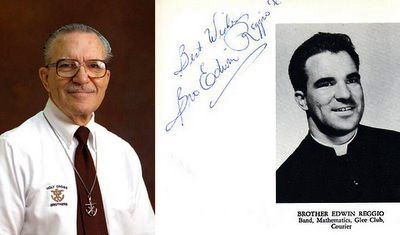
The certainty that I would be able to connect with classmates that I had known for four years but somehow had not been my friends ( a mere sharing of a living space in a boarding school) has been a pleasant one. I have connected and spoken with these men that were boys once and discerned a warmth and intelligence in them that would have been missed by the stupidity of my youth.
The icing on the cake has been my two day visit with Brother Edwin. Yesterday he took me on a two-hour tour of the Austin lake district in a Chevrolet Lumina. This happened after lunch (again in the inner sanctum of St Joseph Hall.)
I saw new sides of the man when he went to the communal garden and banged a stick on the wall. A squirrel appeared and came up to him as he put corn and nuts into a little bowl. We passed by a little room with a barber chair. I asked. "I am the barber here.” I asked him who shaved the barber. "That's Brother Thomas." Brother Thomas was repairing the very old curtains of the Brothers' living room. He told Brother Edwin, "We are going to need new curtains soon." With money tight I know Brother Thomas will fix them.
In the memorial recognition lunch today we remembered those brothers, faculty and students who had been there before us (Brother Edwin's euphemism for those who had died). He opened the lunch with this poem:
To Remember You
A bouquet of beautiful memories
we place before our graves.
We wish we could be with us
as we recall the good old days.
We the Men of Tigertown
pledge our prayers for you.
You are still with us in those "Good old days"
as we remember the "Old Gold and Blue".
Brother Edwin Reggio, CSC (Congregation of the Holy Cross).
All that maudlin, but wonderful, content of above needs a little bit of irreverent balance..
We stood up to sing our school song (lyrics and music by Brother Edwin, naturally!) I never bothered to learn the words because I had to play the song on the alto saxophone. I was a member of the school band, not by choice, but by a gentle pressure from Brother Edwin who had diverted me and then fished me one day on my way to the cafeteria.
The song reminded me that at school football games, the cheerleaders would be in front of us and at the end of the song:
The Blue, fight, fight!
The Gold, fight, fight!
I would be rewarded by a rapid glimpse of Judy Reyes' fine legs and...as she jumped up in the air.
Vanillla Ice Cream, Rolling Thunder & My Friend A White Frog
Friday, June 12, 2009
Rosemary was as always absolutely right in sending me to the St. Ed's Reunion two days early. I have been able to linger in conversation with Brother Edwin Reggio who keeps inviting me for lunch at the inner sanctum of St. Joseph Hall. I had egg plant parmigiano which was delicious. Nobody back in Vancouver likes egg plant so that was a treat.
A kindly looking man in glasses came up to me in the afternoon and asked, " Are you alex?" I countered, " Are you Milton?" I had not seen Milton Hernandez, class of 1960) since 1961. He came along with us, Brother Edwin, John and Carolyn Arnold to the County Line where we enjoyed Texas barbecue. The best was the conversation and the peach cobbler with homemade vanilla bean ice cream.
As we left for home (St. Ed's) Carolyn received a phone communication from her daughter informing her of a tornado warning for the evening. The tornado never happened but...
I sat down on one of the benches (I moved it to the centre and placed it right next to the big red door of the front entrance of Old Main and I watched the most spectacular electrical storm form 8:45pm until 10:00pm. The city skyline was sharp and brilliant and the lightning bolts were covering a 150 degree sweep of the horizon. I could see the clouds behind (North West) move in my direction and the rain made the city disappear. Soon the rain and the thunder came upon me and the noise was constant. It made me remember LBJ's Operation Rolling Thunder which was his failed attempt to end the Vietnam war from March 1965 to November 1968. I am sure that my friend Howard Houston (class of 1961) was busy fueling fighters from his Boeing KC-135 tanker.
The electrical storm last night was rolling thunder. I was not alone from my vantage point on the best seat of the house. A little white frog hopped up the stone stairs and stared at me. He ate some insects and then hopped back down. As the rain increased to the level of a deluge he came back up. As the lightning bolts receded I bid the frog goodbye and I walked to my room at Moreau Hall.
It has been a long time since I have been able to feel so at peace with my happiness.
Harvey's Last Chance & A White Apparition
Thursday, June 11, 2009

It is a curious fact that wherever Rosemary and I go we always think, "Would Rebecca like this?" When we watch a film we wonder if it would be appropriate for Rebecca and if it would help her learn."
There I was on board a Continental Boeing 737 watching Dustin Hoffman and Emma Thompson in Harvey's Last Chance knowing that it was the perfect film for Rosemary. I suddenly missed Rosemary very much and wanted her right there.
I was picked up by John Arnold at the Austin Airport. The last time I had been there was in 1959 when I had passed my hand on the razor edge wing of a Lockheed F-104 Starfighter. It was Bergstrom Air Force Base. As my 737 landed I could see vestiges of WWII buildings and grass growing over old runways. The vision of the past faded as the jet taxied to the modern airport.
John and I drove to St. Ed's and when we saw the tower of the Old Main we knew we were home.
We had an unusual supper with Brother Edwin and the other Brothers at St. Joseph's Hall. This was unusual as this was an inner sanctum we were never able to penetrate in our youth. And there was Carolyn Arnold (John's wife) surrounded by men in what in previous times would have been a cloister situation. We felt lucky and blessed.
The evening ended in magic. We were in back of Old Main and we saw what seemed at first to be an aparition. A tall woman in flowing white robes (Carolyn noticed she was wearing heels) passed by. Could she have been a nun? She was so. Brother Edwin confirmed there are three nuns from Ghana on campus.
The Three Of Us & Four In A Corvair
Wednesday, June 10, 2009

When Rebecca took this series of Pictures of the three of us (she is pressing a bulb with one of her hands) last Saturday, Rosemary told me that Lauren had closed her eyes for all of them. Rosemary, for once, was wrong and Lauren not only managed not to blink but somehow the three of us posed with pleasant smiles. I am holding a tiny hosta called Cat’s Eye and Rebecca is proudly showing her potted Hosta ‘June’. My Hosta ‘June’ is behind. They are different because Rebecca’s is a North American tissue culture (cloned) plant and mine came from a division of an English plant. Rebecca is aware of this and she is jealous. I think I might have to cut a chunk out in the fall for her. After all I should reward her sense of good taste!
As I fly to Austin and to my teenage roots I will keep this picture in my head should I get depressed about soon finding myself in a room with all of us old, bald and paunchy.
I will look forward to meeting up with Captain Henry Harper. On the last day of school, on the day of our graduation I did not go to the prom because I could not dance and I was too shy to ask a girl. Harper felt sorry for me. At the time his father was on officer at the nearby Bergstrom Air Force Base (now the very Ausin Airport my plane will land on). He invited me to a pool party at the base. I remember running after girls in bathing suits with chunks of watermelon in my hand. The game was to throw them at them or rub them on. I believe that was the first and last pool side watermelon party I ever went to. After the party, Harper found me a date and the four of us (Harper had no problem getting his own dates) went cruising and parking in a Corvair. In my late teens I finally discovered the overture delights of a woman.
A La Francesa
Tuesday, June 09, 2009
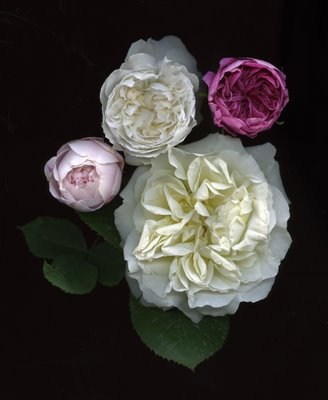
Since my Spanish grandmother was born in the 19th century many of the things she told me had to do with her memories as a little girl. The Catholic world of Spain and her former colonies were still socked by Darwin. “Asomar el rabo” or to show one’s tail was how my grandmother would describe a person’s faux pa. They did not know any better because they were still close to monkey ancestors.
Napoleon was still big in Spain. Spaniards to this day use the expression “despedirse a la francesa” or, to say goodbye French style which means without saying goodbye”. One day asked my grandmother the origin of the expression. She told me that as soon as Wellington landed in Portugal and started going up the Iberian Peninsula the French noticed. When Wellington began to gain victories the French panicked and left, “without saying goodbye!”
Tomorrow Wednesday I leave for Austin. I have been busy today getting pictures for magazines scanned and tying loose ends. I had to water the garden well and put my pots out of the sun so that they will not dry out so quickly and give Rosemary a bit of a break in the incessant watering she will be doing until the weekend. There seems to be no rain in sight.
I have never noticed Rosemary deadheading my roses as she believes they are my domain. This meant I had to put on gloves and deadhead my tall Blanc double de Coubert. It has tons of tiny prickles so it is a tough job.
Many of my roses like the Gallicas will only bloom once. Some are blooming now and when I come back in a week they will either be waning or over. This is what has made me melancholy.
But my melancholy was lifted by four friends that decided to show their face today. I would assert that they are saying goodbye to me in a most un-French and courteous manner.
The large (5 inches wide) almost white rose, Mary Webb, is perhaps the most fragrant myrrh scented English Rose of my garden. Alas, it is not one of David Austin’s best. I might get four or five flowers in a short span of a few weeks and then it will not re-bloom. She makes up for all those failings by producing large flowers that rival that other English Rose, Gertrude Jekyll.
The smaller white rose, the English Rose Fair Bianca, is almost as myrrh fragrant as Mary Webb but she is remontant and her scent is complex with the addition of hints of lemon and magnolia soap.
The light pink rose is a Bourbon rose that sported from Reine Victoria. She is Mme. Pierre Oger. She is a reluctant bloomer and her canes are thin tall and spindly. But her colour is a translucent pink that is almost white and sometimes a very pale yellow. I have often wondered how a woman’s claim to fame could be her husband’s.
The fourth rose is one that competes with the other three for my favourite. It is the mysterious Gallica Charles de Mills. Nobody has been able to figure out who the man was. This particular bloom is smallish because it has not opened fully. It is the first and it is not even from my own bush. Charles de Mills is notorious for sending runners and offspring plants will pop up. I have two of them. This one I have promised to Rebecca and I will dig it out for her in the fall. It is most appropriate that Charles has said goodbye courtesy of Rebecca and there is a small possibility that when I return he will still be around to greet me back.
A Somber Cardinal Richelieu Cheers Up
Monday, June 08, 2009
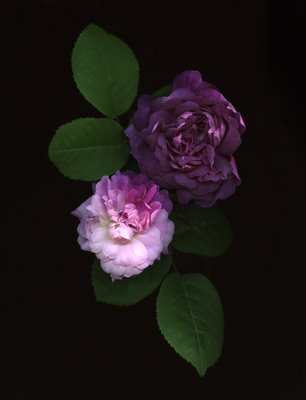
'Cardinal Richelieu'
Laffay France c. 1840
When I first started scanning my roses some years back my first intention was to use the process to accurately record the status of a particular rose on a particular day. I scanned them then and now at 100% size so that anybody perusing my files of roses (somewhere around 500 of them) would see a rose pretty well they way it appeared. When possible I try to make sure that my scan resembles the colour of the rose as closely as possible. As inaccurate as this may seem the result is far more accurate that that of either a film camera or a digital camera. The former will show roses with disparate colour depending on the film stock used (film stock is affected by latitude so that pictures taken further north will be a tad bluer) the time of day the pictures are taken or if they are taken on a cloudy day or under the shade of a tree. So few digital photographers have well calibrated monitor screens that the colour of a rose could be awfully suspect.

Anybody looking at these two different scans of the Gallica Rose, Cardinal Richelieu would be convinced they are not the same plant. The first one above is a scan I did today. The other one was June 18, 2007. The fading colour and the beautiful stage towards decay that most Gallicas have as an extra feature are here to be enjoyed. The rich purple flowers fade to a metallic bluish purple. What is strange that in a dryer and hotter spring, 2009, the bush seems to be later in comparison to 2007. The 2007 Cardinal had those spent blooms while today I found the open ones and there was one bud about to open.
Anybody looking at that first scan would wonder which rose is the real Cardinal Richelieu. For most of us who have enjoyed reading Alexandre Dumas’ Musketeer saga and seen all the films, Cardinal Richelieu is Vincent Price just like Lady de Winter was never better than when she was played by Lana Turner. Dumas’ Cardinal as a conniving power hungry cleric is mostly from the writer’s imagination. We do know that the Cardinal was a patron of the arts. Perhaps my particular plant is showing the man in his true colours and there was a gayer side of him we never knew. That would explain the less somber colour and the many shades of that one single but extraordinary bloom.
Will William Lobb Be Around? What Melancholy
Sunday, June 07, 2009
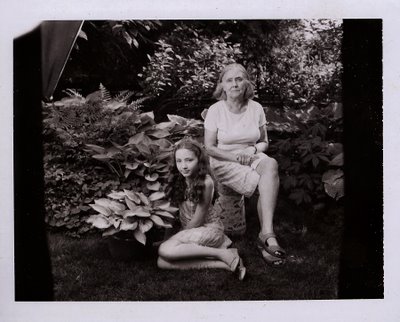
I am off to Austin this week for a school reunion. I should be all excited about seeing people I have not seen since 1961. Yet I feel heavy melancholy.
I will meet old friends who in some cases weren’t friends but now with some mutual maturity there will be ample opportunity to make new friends of these old friends. They are a varied bunch. One is a captain in the navy but is an expert on nuclear reactors and he even owns some float planes. Another has the largest factory in the US (in Arizona) that makes adobe bricks. A roommate of mine told me he was going to be a dentist back in 1958. He is a dentist in Houston. A few don’t remember me at all even though we were boarders together for four years. One of them has a funeral home and the other is a Vietnam veteran who lives in Maine. Perhaps the most brilliant of our class is the man who works with the Mars Rover for NASA. Closer to home in Austin there is John. Everybody says he is a former spy or a former FBI or CIA agent. He denies it and “does not do computers”. This latter inability may confirm his assertions. On the other hand…
This should be exciting. But the melancholy persists and I know why. I am going to miss my friends from home. Two of them are in the Polaroid (I bought some Polaroid film and kept a small stock when I found out the company was pulling a GM). I took the snapshot on Saturday to set up the focus on m big camera to photograph Rebecca and me. In the end she pressed the bulb as she wanted it to be her self-portrait.
Many of my roses have lots of buds. The moss rose (it is a smallish shrub as I purchased it only a year ago) William Lobb has 117 buds. Rebecca counted them. Alas they may be open and over by the time I come back. Not only will I miss my friends Rosemary and Rebecca (and Lauren and Hilary) but I will also miss all these roses that are checking in from last year. Some have checked in with surprises. The new (20th century) Gallica rose James Mason has a lighter less deep red colour. Rosemary was disappointed in him. As I wrote a few posts back Gertrude Jekyll is back bigger and with an even more powerful scent.
Today I even discovered roses that had opened in the middle of the day.
I will reluctantly leave my friends behind (including Plata and Toby the cats). Perhaps I will cheer up on the way. If not I will cheer up about coming back to my old friends.
Gertrude Trumps Eglantine
Saturday, June 06, 2009
What is one to say about June, the time of perfect young summer, the fulfillment of the promise of the earlier months, and with as yet no sign to remind one that its fresh young beauty will ever fade.
Getrude Jekyll
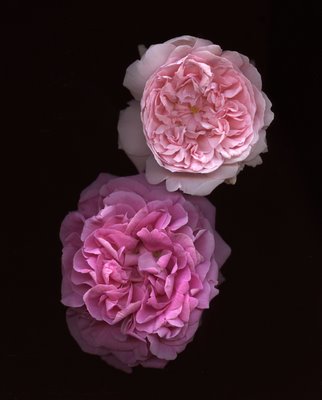
Because I am leaving for Austin, Texas soon for my St. Ed’s High School reunion I am preparing Rebecca for our lecture/presentation at the Vancouver World Rose Festival from June 19 to June 21. Our presentation is called A Rose Through a Child’s Eyes. Today we looked at 30 more roses in the garden. In her neat handwriting Rebecca wrote their names and other salient facts like colour and scent. She had never heard of Hybrid Perpetual Roses which were introduced in mid 19th century. They were certainly not in bloom perpetually but were remontant.
There were two roses that attracted Rebecca today and both are English Roses. The top one is called Rosa ‘Eglantine’ and the bottom one is Rosa ‘Gertrude Jekyll’ She already knows a few things about Miss Jekyll (rhymes with treacle). Rebecca would tell you that this plain-looking 19th century English woman was an expert gardener who stated that the whitest white in a garden was the rugosa rose, ‘Blanc double de Coubert’. Both Rebecca and I have that rose but Rebecca’s has yet to bloom as it is brand new since I bought it for her at the VanDusen plant sale this year.
Rebecca had protested when I had told her to turn on the TV. Once she was outside writing down the rose facts she began to jump from Eglantine to Gertrude Jekyll trying to figure out which of the two she liked best. While I think both smell the same even though Gertrude is stronger, Rebecca did discern some differences. She also liked Gertrude’s larger size.
After our home-made pizza dinner Rebecca took Lauren and her mother Hilary to the garden for a tour of the garden roses. I stayed inside and watched proudly from the living room window as Rebecca explained. I had asked Rebecca earlier if she was not going to freeze in front of the many people who would listen to her at the festival. “Not a chance!” she asserted.
Mala Yerba Nunca Muere
Friday, June 05, 2009
Mala yerba nunca muere, y si muere no hace falta.
A bad weed never dies, and if it dies it's not needed.
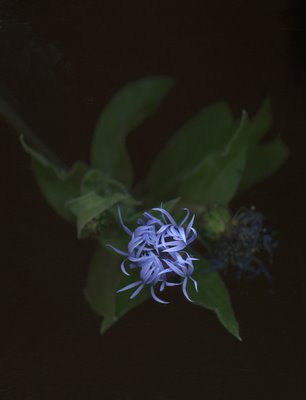
While going for a walk this afternoon I spotted a weed coming out of a neighbour's hedge. Rosemary and I make a habit of occasionally pulling some of the weeds we may spot as we don't want them to land in our garden. One, specifically is morning glory. I was about to pull the one in the picture (Centaurea montana) when I noticed the flower. It is commonly called a Bachelor's Button and it is a perennial cornflower. I decided to scan it and I think I have been rewarded by the beauty of a plant that most people will either ignore or simply not notice.
While having tea with my friend Abraham Rogatnick on Thursday, he said to me,"So many people when they see the extraordinary beauty and diversity of nature must then need to believe that they were created by someone." Both of us believe in a final end. But I remained quiet. As I look at the beautiful detail of Cantaurea montana it would be comforting to believe in the immortality of this weed and other life forms. But it's beauty is somehow enough.
Mary Rose & That Hamilton Woman
Thursday, June 04, 2009

Early in the spring after our terrible recurring winter we lost most of our New Zealand hebes, our Ceanothus and at least 10 roses. Some of my dead roses were classic favourites of mine like Rosa ‘Reine Victoria’, 'Bishop of Darlington', Chinensis x odorata ‘Mutabilis’, William Shakespeare, Ballerina, the Fairy, Sally Holmes and the rose that reminds me most of Rebecca Mrs Oakley Fisher. I purchased replacements (not all were available). I should have known better. Death isn’t quite as final in the rose kingdom. I cut the dead roses to the ground and hoped. All came back with the exception of the 'Bishop of Darlington' and 'Reine Victoria'. 'Mrs. Oakley Fisher' is about to bloom and every day that I venture into the garden in the morning an old friend is likely to pull a botanical Lazarus.
I have written before that Nick Lowe’s great pop song, Cruel to Be Kind should be the anthem of rose care. Roses must never be allowed to have aging canes or very tall ones. I have left these canes grow year after year until the canes brown and there is a restriction of sap to the new shoots from where the new roses will bud. The solution is to be heavy handed and to be brutal (cruel) and cut them as far down as one can. This forces the rose to fight for its life. It protects itself by forming new shoots from the base. This was the case even with a rose that looked as dead as it could be like Mutabilis. It had grown to about 26 feet and the canes were bigger in thickness than a walking cane. The new shoots are already four feet. It will bloom soon.
The rose here is an English Rose. It is Rosa ‘Mary Rose’. When I saw her this morning it was like seeing an old friend come back from a vacation. I had missed her without knowing and there she was beckoning to my sniffing sense. She smells of myrrh. She is named after Henry VIII’s flagship that sank before it even sailed. Not too long ago she was found and brought back up and boxes and boxes of long bows were found. They were dried. They then were re-strung and tested. One needed a 100 pound pull to get the string to the cheek.
Rebecca will takeover the narrative and explain here that the several yews in my garden (Taxus) were much the same as the English yews from where they made the long bows that English and Welsh bowmen used to penetrate the French armour and defeated them at Agincourt and Crecy during the 100 Year's War.
My point being that historical association is what has made Rebecca ultimately so interested in growing roses. One of my new roses is Horatio Nelson. Perhaps in a few weeks Rebecca and I will watch Vivien Leigh and Laurence Olivier in Alexander Korda’s 1941 film That Hamilton Woman. When Horatio Nelson blooms he will seem like an old friend to us both. And of course we will not forget to be cruel so as to be kind.
Love Is A Shocking Pink/Purple Swan
Wednesday, June 03, 2009
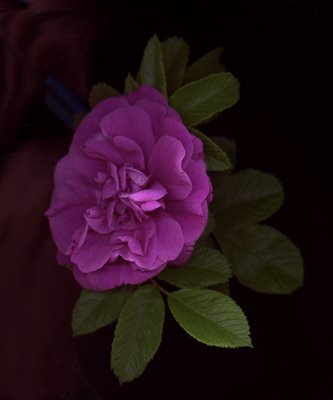
My mother and I, when I was in my late teens, often discussed the topic of love. love. She would say to me, “Love is not demonstrations of it. Love is doing.” She sacrificed in many respects her happiness by working very hard to put me in good schools that strained her financial situation to the limit for most of her life. And I was most unappreciative. Instead of thanking her in some way I would keep on, "I want..." My mother seemed to think that outward forms of affection were secondary to doing. It was my father who I remember kissing me and when he did there was that whiff of whiskey and Player's Navy Cut with a hint of lavender. I loved his smell.
When my mother was in her late 50s she confessed to me that she missed that affectin that she had disdained for so long. Suddenly doing and giving weren't good enough. To this day I regret in not having showered her with the affection she craved. She had taught me too well.
This morning when I went to see which roses had opened I noticed a hybrid rugosa in bloom. She is Rosa 'Hansa'. Of her my rose bible, Peter Beales' Classic Roses says:
Schaum and Van Tol Holland 1905
Very free flowering. Doublem, highly scented, reddish-purple flowers. Vigorous, medium sized plant with dark green foliage. Excellent red fruit. This is one of the best all-round roses.
Hansa means duck or swan in German and Sanskrit. The Hanseatic or Hansa League was an alliance of cities and their guilds in the late middle ages. Whichever way you look at it that name, Hansa, does not have the ring of Rosa 'Emma Hamilton', 'Mrs. Oakley Fisher', the Fairy or Ballerina. It is a sturdy name for a sturdy rose that happens to have an overpowering scent (it goes up the nose like Keen's Mustard) and once it is lodged in your memory it is sublime. The scent has to compete with a colour that would probably glow in the dark. Subtlety of colour is not Hansa's strong suit.
Yet when I spotted her this morning I immediately remembered with a rush of pride and love for the person who gave her to me. It was my oldest daughter Ale. For a couple of years this "free flowering" plant refused to reward me with any flowers. Last year her behaviour was sporadic. This year she is coming in strong. I wanted to find Ale and give her a big kiss and a hug. Giving a rose to someone is most personal. It's not like a bouquet of mums. A gift rose is serius business. It is serious giving. It is a serious giving my mother would understand. But unlike my mother I am willing to admit that the giving is not enough if I cannot correspond in some way with some loving, the sweet and corny sentimental kind. Yes Ale, I your father love you a lot and I love and appreciate this wonderful shocking pink/red/purple swan.
Six Brothers Chip In To My Photographic Career
Tuesday, June 02, 2009

The first camera I ever saw was my Uncle Tony’s Kodak box camera. Thanks to my Uncle Tony there is a pretty good record of my childhood in Buenos Aires. Many of his pictures he took in our Melián garden. I suspect it was Uncle Tony who took all my birdthday group photographs which are some of he few I have where I can see my father.
It was in Buenos Aires, at the Lincoln Library (a United States Information Service sponsored propaganda establishement) which was at the even then fashionable Florida Street where sometime around 1951 when I was 9 where I saw a photograph that I think changed my life. At the very least it pointed me in the direction of my becoming the photographer I am today. It was an journal of the American Heritage Society and the picture was one taken by Timothy O’Sullivan of the dead on a battlefield of the American Civil war.
In 1951 the only magazines I was familiar with were Billiken, an Argentine children’s magazine and the historietas (comic book magazines) that my mother bought for me at our Coghlan train station. They were Ratón Mickey and Pato Donald. That first photograph I saw in the American publication was (unlike the images in the Argentine comic books) incredibly sharp and the dead soldiers look for real. There were portraits of Lincoln with General Grant by Matthew Brady. The men looked like they could walk out of the page. I made the math that the people in the photograph had been dead for about 97 years. In comparison to what I had learned in my history classes at school that did not seem to be such a long time.
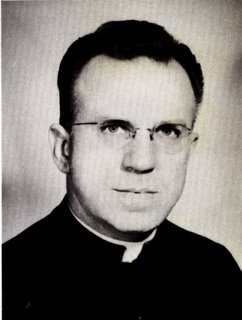
In 1958 when I was in grade 10 at St. Ed’s High School in Austin Texas, Brother Vincent de Paul (top, centre) and Brother Dunstan Bowles (below, right) organized a bus trip to Washington DC. It was in Washington DC that I spotted an Agfa Silette in a pawn shopt. I have no idea how much I paid for it. The pawn shop attendant even had film. I asked him what film he recommended. He said, “Kodak Tri-X is the best film you can buy.” This I did.

It took me a year to feel the frustration of this beautiful camera’s limitations. It had no rangefinder so the focusing was by guessing the distances. I felt frustrated that no matter how hard I tried I cold not unscrew the lens. It dawned at me that the one lens it had was the only lens it would ever have.
It was in grade 11 that I made up my mind that I needed to buy a new camera. The one I wanted was similar to the one that my friend Brother Anton Mattingly (below, left) had. We both spoke Spanish. I took his Spanish class instead of Latin thinking it was the lazy thing to do. I soon learned I was not going to be as easy as I thought it would be. Brother Anton taught me Spanish grammar. He liked to take snapshots with the most beautiful camera I had ever seen. It was a Pentacon with a Zeiss Biotar F-2 58mm lens.

At the time I worked for Brother Hubert Koeppen (below, right). He paid me wages to clean the basketball gym and to work with him in his shop where he sold model cars and airplanes. It was there that we re-used all the paper streamers that he and I would use to decorate the school dances. We would carefully bring them down. I woul roll them carefully into rolls and staple one end to another. We had boxes of red, orange, white, green, etc coloured streamers.
One day Brother Hubert took me to a place where he warned me in advance that it was a secret I had to keep. We got into an old truck that had a putrid smell. The back was full of old rags. He took me to some nearby warehouse where we dumped the old rags into a room that was full, from floor to ceiling with more rags. He explained that he sold the rags to a paper company and that with the money he bought the supplies to varnish and keep the gym floor in tip top shape. I imagined then that Brother Hubert would have done well as a concentration camp inmate as he would have stored everyything and found use for all of it.
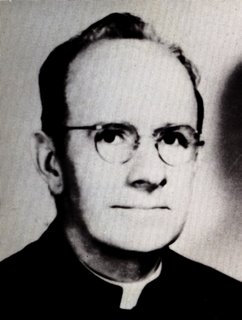
Working with Brother Hubert was a tough job but there was the extra pleasure of being exposed to his corny humour and erudite stories of ancient history. I was teased by the Latino contingent of the boarding school. Brother Hubert wore a very large black hat and a black cape. He was given the sobriquet “El Vampiro”. And since I was his helper I was dubbed “El Vampirito”. But I had a goal. I was going to buy the newer model Pentacon-F with a Zeiss Biotar F-2 58 mm lens.
When I thought I had enough money I realized I could not afford the Biotar but had to settle for the lesser Zeiss 50mm F-2.8 Tessar. I ordered it from Olden Camera in NY City and Brother Emmett Strohmeyer (below, left) who ran the school bookstore and just about anything else shop got me the money order.
Some weeks later as I was passing by the store Brother Emmett stopped me to tell me had a big box for me. It was my Pentacon-F. It was the most beautiful camera I had ever seen. The knobs to wind and re-wind the film were much bigger than in Brother Anton’s!
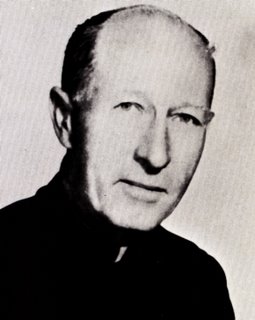
It was with the Pentacon-F that I learned phtography. Within a few months I had saved up enough money from Brother Hubert’s job to buy an extrmely fast (for the day) F-1.8 Komura 80mm lens. I could switch lenses to my heart’s content. This camera had interchangeable lenses. And my camera was cutting edge. In 1959 there was a heated argument that the new-fangled single lens reflex cameras were no match to rangefinder cameras. But my happiness with my Pentacon-F was short-lived.
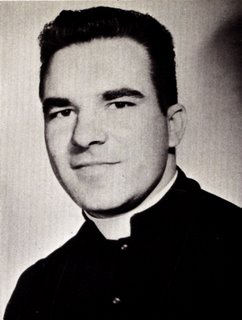
Brother Edwin Reggio, right, (one of his tasks was to shoot the photos for the school annual, the Edwardian) bought a brand new Konika F which had a built in light meter system. It also had a metal, vertically running Copal focal plane shutter. Brother Anton and I were left with dated pieces that if not junk they were close to it. To make my jealousy worse Brother Edwin added insult to injury by waylaying me on the way to lunch to inform me that I was going to be his new alto saxophone player for the school band. Since I did not even know how to read notes I could not understand why he had chosen me. But cleaning the band hall for Brother Edwin gave me extra wages to pay for my camera and film expenses. Would it be possible that I could then buy a Konica? I never did but I bought another camera, a used one in Mexico City in 1962.
In Mexico City before I left for my stint in the Argentine Navy in 1964 I had purchased a used Pentax S-3. It had the same lens mount as the Pentacon. I could shoot colour slide with one and b+w with the other. At the time I used brands such as Afga, Ferrania, Adox besides the usual Kodak Tri-x. In 1964 before I left for Argentina I won first prize at the annual university competition at Mexico City College. I never really did notice the judge who signed my diploma. He was an obscure (to me) Mexican artist called Rufino Tamayo. But the prize did put in my mind that perhaps photography could be an interesting hobby.
The two cameras recorded my stay in Buenos Aires and my meeting up with my soon-to-be wife Rosemary Healey in Mexico City in 1967/68. The two cameras recorded the birth and growth of our two daughters Alexandra and Hilary. I took the role of Uncle Tony and photographed all of my daughter’s birthday parties in Arboledas, Mexico. The groups had at least 50 children in them.
In 1975 we decided to abandon the financial and political uncertainty of Mexico for Vancouver. I made the decision to give up my high school teaching and English teaching in American companies. I had the ambition to start from scratch in Vancouver as a photographer. On the way to Canada in our VW Beetle I dropped off my daughters and Rosemary at Disneyland and I drove to a camera store and bought new Pentaxes, new exposure meters and lights. I was going to be a professional photographer.
Educación - Manners & Upbringing
Monday, June 01, 2009
A la primera, perdón; a la segunda con el bastón (The first time a pardon. The second time a caning.)
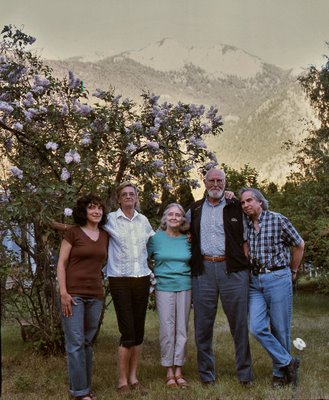
A week ago on Saturday, Rosemary and I took my first cousin Willoughby Blew and his wife Chris to Lillooet to visit my eldest daughter Ale. For me it was glorious as I was “en familia” which is a Spanish term which sort of means “happily with family”. The Blews seemed to enjoy the scenery and had no problem with the intense curves between Pemberton and Lillooet. I cooked in Lillooet and on Sunday before driving back to Vancouver we were treated to a full breakfast at the venerable (for Lillooet) Reynolds Hotel. As soon as the Blews settled back home in Florida they sent nice thank you letters to us and to Ale. The e-mails were full of praise for our daughters, granddaughters and much was mentioned of our beautiful city and our own Kerrisdale garden.
In short, I was proud that my side of the family showed “educación”. This does not only mean education but upringing and manners, too.
All that helped to make my first day of school at a local photography school (I teach at two) all that much of a shock. Within ten minutes of facing a new class of 19 students I found that one was giggling. I enquired as to why she/he was giggling as I was not saying anything that was remotely funny ( I was probably describing how difficult it is to be a magazine photographer right now). My student answered that having the preference to play a computer game at home that would have been the option but, since parents were paying for tuition some obligation was felt on his/her part to be in class, albeit playing that computer game anyway. Satisfied (but still shocked) at the reply I spotted another student (it was 10:30) about to bite on a large hamburger. I averted my gaze to another area of the room to find a student yawning repeatedly (hands very far from mouth) with lots of vigour. My student was Latin American so I pointed out, in Spanish, that here was a marvelous opportunity for her/him to show the good manners she/he had been taught by his/her grandmother in the presence of so called “uncouth” gringos.
Another student repeatedly came and left the room with no explanation.
It is my purpose to inspire a few to develop a passion for photography. Not all will be passionate. Just a few perhaps. But sometimes I have trouble trying to figure out what the new standards of behaviour are or if there are any.
All of which made me long for the Blews with a new found nostalgia for that “educación” which seems to be so rare in this day and age.






